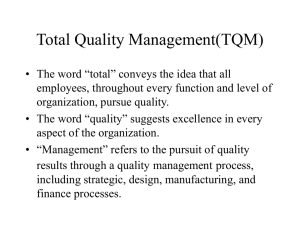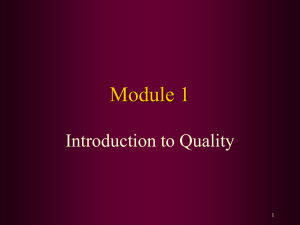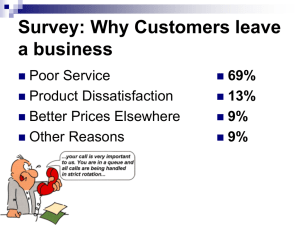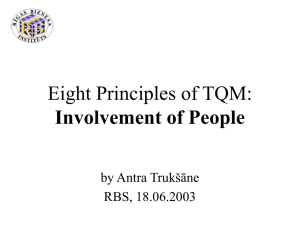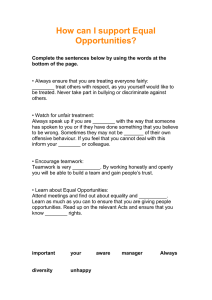Lesson Plan
advertisement
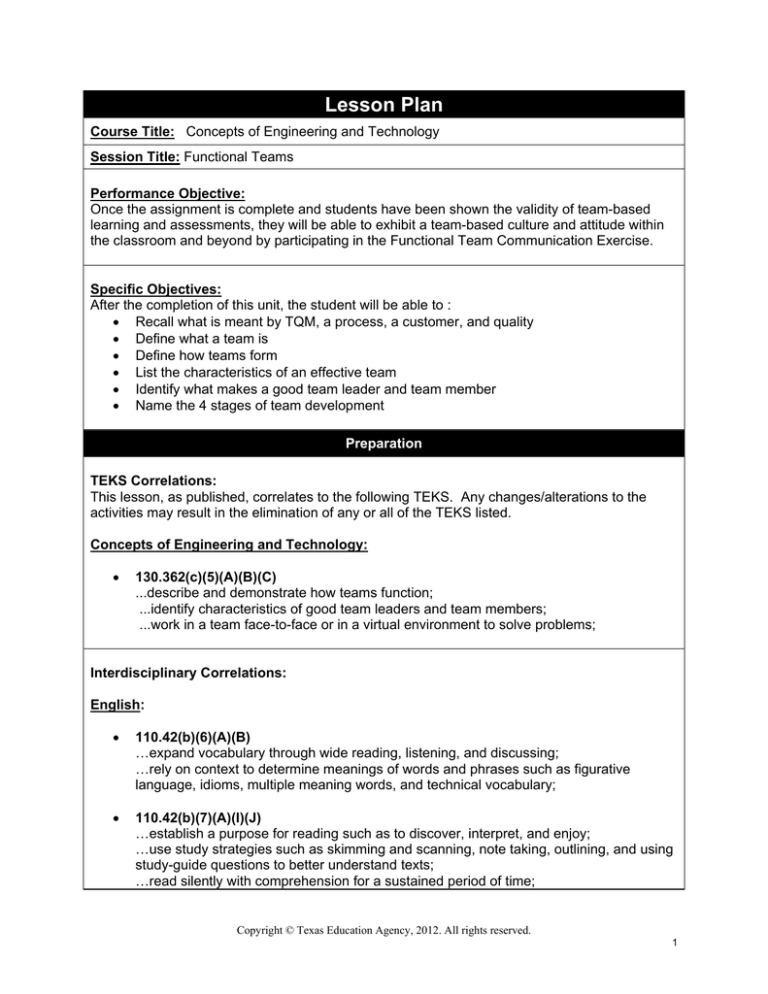
Lesson Plan Course Title: Concepts of Engineering and Technology Session Title: Functional Teams Performance Objective: Once the assignment is complete and students have been shown the validity of team-based learning and assessments, they will be able to exhibit a team-based culture and attitude within the classroom and beyond by participating in the Functional Team Communication Exercise. Specific Objectives: After the completion of this unit, the student will be able to : Recall what is meant by TQM, a process, a customer, and quality Define what a team is Define how teams form List the characteristics of an effective team Identify what makes a good team leader and team member Name the 4 stages of team development Preparation TEKS Correlations: This lesson, as published, correlates to the following TEKS. Any changes/alterations to the activities may result in the elimination of any or all of the TEKS listed. Concepts of Engineering and Technology: 130.362(c)(5)(A)(B)(C) ...describe and demonstrate how teams function; ...identify characteristics of good team leaders and team members; ...work in a team face-to-face or in a virtual environment to solve problems; Interdisciplinary Correlations: English: 110.42(b)(6)(A)(B) …expand vocabulary through wide reading, listening, and discussing; …rely on context to determine meanings of words and phrases such as figurative language, idioms, multiple meaning words, and technical vocabulary; 110.42(b)(7)(A)(I)(J) …establish a purpose for reading such as to discover, interpret, and enjoy; …use study strategies such as skimming and scanning, note taking, outlining, and using study-guide questions to better understand texts; …read silently with comprehension for a sustained period of time; Copyright © Texas Education Agency, 2012. All rights reserved. 1 Teacher Preparation: A functional team consists of 2 or more members who have a high level of communication and can act cohesively together under all types of conditions. The team numbers that function best are from 2- to 5- member teams. All members must have clearly delineated goals once the team is formed. Otherwise, dissension will start to grow within the team and timelines and team goals will not be completed. After the initial lecture on functional teams and completion of the PowerPoint presentation, the teacher should have the handouts ready. References: Deming, E. (2000). Out of the Crisis. Massachusetts: The MIT Press. Instructional Aids: 1. Functional Teams – Teamwork Through TQM PowerPoint presentation 2. Functional Team Vocabulary – 1 per student 3. Functional Team Vocabulary Assessment – 1 per student 4. Functional Team Vocabulary Assessment key 5. Functional Team Communication Exercise – 1 per student or team Materials Needed: 1. Pencil or pen 2. Each team member has a 2-foot section of PVC pipe of 2” diameter. 3. 1 golf ball 4. 1 gallon or larger bucket 5. Stopwatch or timer Equipment Needed: 1. Computer 2. Projector 3. 2 tables, 10 feet apart Learner Preparation: 1. Read Out of the Crisis excerpts from text. 2. Watch Functional Teams: Teamwork Through TQM PPT presentation and takes notes. 3. Complete Functional Team Vocabulary Assessment 4. Participate in Functional Team Communication Exercise and debrief with instructor Introduction Introduction (LSI Quadrant I): SAY: Working as a team in today’s industry is the norm. Individual work is now the rarity. ASK: What does a team mean to you? SAY: A team has many stages during its development. ASK: How many stages and what are they called? (Answer: 4 stages: Forming, Storming, Copyright © Texas Education Agency, 2012. All rights reserved. 2 Norming, and Performing) SHOW: Functional Teams - Teamwork through TQM PowerPoint presentation. Outline Outline (LSI Quadrant II): Instructors can use the PowerPoint presentation, slides, handouts, and note pages in conjunction with the following outline. MI Outline Notes to Instructor I. What is TQM? A. TQM was initially developed by Dr. W. Edward Deming. B. Dr. Deming was instrumental in developing the quality control techniques used during WWII. C. After the war, General McArthur had Deming go to Japan and helped Japan rebuild their industrial leadership techniques. Teacher begins Functional Teams: Teamwork Through TQM PowerPoint presentation. II. What is a process? A. A “process” is defined as, “an integration of people, material, methods, and machines used to produce, with value added, output for customers”. Teacher discusses what a process is. Slides 1-3 Slides 4-5 . Teacher discusses III. What is a customer? what a customer is. A. The people (or person) for whom the output (product or service) is being Slide 6 produced. B. Customers are the people who will use the output directly or who will take it as an input into their work process. IV. What is quality? A. Quality as defined by TQM: “Quality is determined by the customer.” B. Which means it is immaterial to what you or Teacher discusses what quality is. Slides 7-9 Copyright © Texas Education Agency, 2012. All rights reserved. 3 the team want. C. What our customers want is what matters. V. Team A. A group of people pooling its knowledge, skills, and talents to attain a common goal or shared purpose. B. Simple rule of thumb to gauge team success: If the individual could have done better alone than with the team’s results, then everyone on the team failed. C. Developing effective teams takes TIME! Teacher discusses what is meant by working as a team developing effective teams. VI. Team effectiveness A. Characteristics of an effective team B. What makes a good team member C. What makes a good team leader Teacher discusses what is meant by effective team member and leader. VII. Stages of team development A. FORMING: The first instance a team is together and they have little to no understanding of goals or acceptance of one another. Interpersonal communication is low-level and sporadic. B. STORMING: When the first conflicts arise. Members are defensive and competitive. Power struggles develop at this point. C. The fastest way out of these first stages is with mid-level communication, preplanning, and mutual respect. D. NORMING: This stage occurs when members become more comfortable with themselves. This also is triggered by their first success, a sense of cohesion develops. Trusting in one another begins. E. PERFORMING: This is the highest level of teamwork. All members are openly supportive of each other as well as openly expressive. The team quickly resolves disagreements. Intuitive reactions Teacher continues PowerPoint presentation and discusses the four stages of team development. Slide 10 Slides 11-16 Copyright © Texas Education Agency, 2012. All rights reserved. 4 between members occurs. Verbal Linguistic Logical Mathematical Visual Spatial Musical Rhythmic Bodily Kinesthetic Intrapersonal Interpersonal Naturalist Existentialist Application Guided Practice (LSI Quadrant III): The teacher will lead the discussion and explain how the students are to complete the Functional Team Vocabulary Assessment and Functional Team Communication Exercise and debrief of exercise. Independent Practice (LSI Quadrant III): Students will read Out of the Crisis excerpts from text and complete the Functional Team Vocabulary Assessment. Summary Review (LSI Quadrants I and IV): Question: How do teams function? Answer: Teams function differently based on their communication and goals. Question: Identify what makes a good team leader. Answer: A good team leader has the following qualities: A vision for the team’s goal(s); shows initiative; good interpersonal skills — both listening and speaking — and a consensus builder. Evaluation Informal Assessment (LSI Quadrant III): Teacher will observe the students as they participate in the Functional Team Communication Exercise and debrief exercise. Formal Assessment (LSI Quadrant III, IV): Functional Team Vocabulary Assessment. Extension Extension/Enrichment (LSI Quadrant IV): The teacher can organize a cross curricular activity with psychology teacher at the school. The activity would be for the team to interact normally during the course of instruction and the psychology class to observe and report on the behavior of the team. During the next session, Copyright © Texas Education Agency, 2012. All rights reserved. 5 feedback for each team would be reviewed. Copyright © Texas Education Agency, 2012. All rights reserved. 6 Functional Team Vocabulary 1. Team – A group of people pooling knowledge, skills, and talents to attain a common goal or shared purpose. 2. Forming – The first instance a team is together. They have little to no understanding of goals or acceptance of one another. Interpersonal communication is low-level and sporadic. 3. Storming – When the first conflicts arise. Some members are defensive and competitive. The team notices power struggles developing at this point. 4. Norming – This stage occurs when members become more comfortable with themselves. This also is triggered by their first success, a sense of cohesion develops. One or more teammates trusting in one another begins. 5. Performing – This is the highest level of teamwork. All members are openly supportive of each other as well as openly expressive. The Team quickly resolves disagreements. An intuitive reaction between members occurs at this stage. 6. Process – An integration of people, material, methods, and machines used to produce, with value added, output for customers. 7. Quality – Quality as defined by TQM: “Quality is determined by the customer.” 8. Customer – The person(s) who will use the output directly or who utilize it as an input into their work process. 9. TQM – Total Quality Management: A process developed by Dr. W. Ed Deming to increase productivity through quality control techniques. 10. Product – The goods or services a company produces for its customer to their specifications. Copyright © Texas Education Agency, 2012. All rights reserved. 7 Functional Team Vocabulary Assessment Match the following terms to the definitions: 1. 2. 3. 4. 5. 6. 7. 8. 9. 10. TQM Quality Performing Product Team Customer Norming Process Storming Forming _____ _____ _____ _____ _____ _____ _____ _____ _____ _____ A. A group of people pooling knowledge, skills, and talents to attain a common goal or shared purpose. B. The first instance a team is together. They have little to no understanding of goals or acceptance of one another. Interpersonal communication is low-level and sporadic. C. When the first conflicts arise. Some members are defensive and competitive. The team notices power struggles developing at this point. D. This stage occurs when members become more comfortable with themselves. This also is triggered by their first success, a sense of cohesion develops. One or more teammates trusting in one another begins. E. This is the highest level of teamwork. All members are openly supportive of each other as well as openly expressive. The team quickly resolves disagreements. An intuitive reaction between members occurs at this stage. F. An integration of people, material, methods, and machines used to produce, with value added, output for customers. G. Quality as defined by TQM: “Quality is determined by the customer.” H. The person(s) who will use the output directly or who utilize it as an input into their work process. I. Total Quality Management: A process developed by Dr. W. Ed Deming to increase productivity through quality control techniques J. The goods or services a company produces for its customer to their specifications. Copyright © Texas Education Agency, 2012. All rights reserved. 8 Functional Team Vocabulary Assessment (Key) Match the following terms to the definitions: 1. 2. 3. 4. 5. 6. 7. 8. 9. 10. TQM Quality Performing Product Team Customer Norming Process Storming Forming __I___ __G__ __E__ __J__ __A__ __H__ __D__ __F__ __C__ __B__ A. A group of people pooling knowledge, skills, and talents to attain a common goal or shared purpose. B. The first instance a team is together. They have little to no understanding of goals or acceptance of one another. Interpersonal communication is low-level and sporadic. C. When the first conflicts arise. Some members are defensive and competitive. The team notices power struggles developing at this point. D. This stage occurs when members become more comfortable with themselves. This also is triggered by their first success, a sense of cohesion develops. One or more teammates trusting in one another begins. E. This is the highest level of teamwork. All members are openly supportive of each other as well as openly expressive. The team quickly resolves disagreements. An intuitive reaction between members occurs at this stage. F. An integration of people, material, methods, and machines used to produce, with value added, output for customers. G. Quality as defined by TQM: “Quality is determined by the customer.” H. The person(s) who will use the output directly or who utilize it as an input into their work process. I. Total Quality Management: A process developed by Dr. W. Ed Deming to increase productivity through quality control techniques J. The goods or services a company produces for its customer to their specifications. Copyright © Texas Education Agency, 2012. All rights reserved. 9 Functional Team Communication Exercise Scenario: A team must move a golf ball from one table to another. The golf ball must be placed into a bucket and must not touch the ground or any member of the team before getting to the bucket. No one on the team may speak to one another. The team has 5 minutes to complete this task. Materials: Each team member has a 2-foot section of PVC pipe of 2” diameter. 1 golf ball 1 gallon or larger bucket 2 tables 10 feet apart Stopwatch or timer Assessment solution: Each member of the team should pantomime their ideas in order to communicate. The basic solution is to form a cascading pipeline to the bucket, where the last one runs to the front of the line. Debrief: Talk about communication during the exercise and what was learned. Body language and facial expressions are realized as more important than previously. Together Everyone Achieves More! Copyright © Texas Education Agency, 2012. All rights reserved. 10


